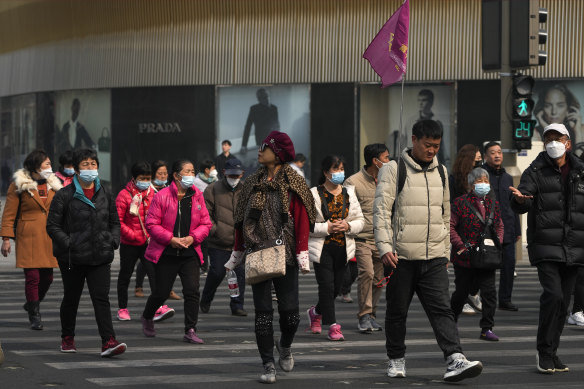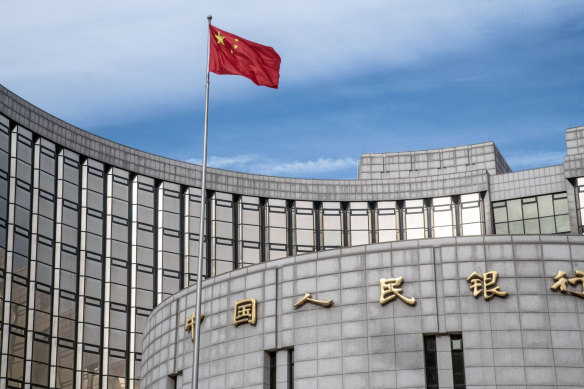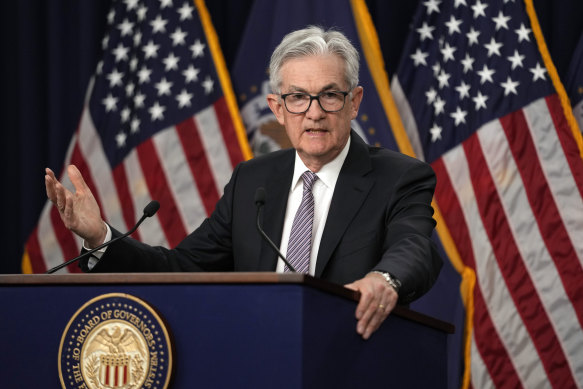Unintended consequences: A new threat is rising in China
Save articles for later
Add articles to your saved list and come back to them any time.
Developments in the US and China this week are showing what could be two sides of the same coin, with signs that the Federal Reserve Board might have finally broken the back of inflation while, in China, the People’s Bank of China appears to becoming concerned about the prospect of deflation.
The US inflation data released on Tuesday was positive, with headline inflation running at its lowest level for more than two years. The annual rate fell from 4.9 per cent in April to 4 per cent in May while edging up only 0.1 per cent on a monthly basis.
China’s economic recovery remains on shaky ground.Credit: AP
Core inflation – with volatile food and energy prices stripped out – rose 0.4 per cent, as it had in April, with prices 5.3 per cent higher than they were a year earlier, although the used car prices and housing costs that drove that outcome appear to have peaked.
The data makes it more likely that when the Fed’s Open Market Committee’s two-day meeting ends on Wednesday in the US, it will pause what has been a cycle of 10 successive rate increases since March last year, the most aggressive increase in US interest rates since the 1980s.
That doesn’t mean the cycle has ended, although it might have, with the markets pricing in one more rise, possibly at the next FOMC meeting next month. Regardless, this phase of US monetary policy appears within touching distance of its end.
China has a very different challenge. Its inflation rate is near zero, inching up only 0.2 per cent last month, with producer prices falling nearly 5 per cent amid weak domestic and external demand. Its economy is clearly slowing markedly.
On Tuesday, China’s central bank, the Peoples’ Bank of China, cut its 7-day reverse repo rate by 10 basis points. While technical and impacting interbank lending rather than interest rates more widely, it effectively injected liquidity into the banking system.
Later this week there is an expectation that the bank will announce a cut to its longer-term policy rate in an effort to stimulate demand for credit and there are also reports that China’s officials are considering a multi-faceted stimulus package to try to increase demand and support their still-distressed real estate sector.
Recent data has shown that China’s factory activity is weak, producer prices have been falling, exports to its key US and South-East Asian markets have slumped heavily – by mid-teens percentages – demand for credit is weak and its property market remains depressed.
Data on China’s retail sales is expected this week and the PBOC’s action suggests that, after bouncing back sharply from last year’s lockdowns, they might be faltering amid continuing high levels of COVID infections.
The People’s Bank of China is growing increasingly concerned about deflation.Credit: Bloomberg
With manufacturing and exports spluttering and the property sector — which once contributed more than 30 per cent to China’s GDP – still distressed, the authorities might feel under pressure to intervene.
The talk of a stimulus package suggests that Beijing, which has been reluctant to resort to significant stimulatory measures, is concerned that the tepid bounce back from last year’s COVID-impacted economy is faltering and that the modest official growth target of “about five per cent” this year is under threat.
That wouldn’t be surprising. The property market has been a major driver of activity in the past but now weighs heavily on China’s growth prospects. Consumers are cautious, youth unemployment in the cities is unpalatably high and China’s traditional reliance on trade to drive growth offers no salvation in a slowing global economy.
Indeed, the contractionary policies employed by the US, European Union and other major advanced economies as they battle 40-year high inflation rates are designed to slow their growth, with spillovers into developing economies and therefore the global economy.
That would inevitably impact a trade-exposed economy, like China’s, even without the distortions to global trade caused by the continuing tariff war on China that Donald Trump started.
Engineering soft landings, whether in the US, China or Australia, may owe as much to good luck as good management.
Joe Biden has continued, and then expanded, the trade war, with sanctions directed at denying China access to advanced technologies, including the critical input to 21st Century products of advanced semiconductors, as well as massive fiscal incentives to redirect investment away from China and towards the US and its allies.
That’s why the monetary policies deployed in the US and elsewhere can be seen to be contributing to the lack of inflation and the economic slowdown in China. It’s one of a number of unintended consequences of the near-unprecedented monetary tightening that the advanced economies have experienced.
Monetary policies are crude tools that, when deployed aggressively to target inflation rates, will inevitably create collateral damage. At what appears to be the final months of the tightening cycle in economies like those of the US, Australia and Canada, there are signs of unintended but not unpredictable consequences.
Fed chairman Jerome Powell is expected to confirm on Thursday morning that the central bank will not be raising ratesCredit: AP
The regional banking crisis in the US, with a spate of bank collapses that spilled over into Europe, was one of them.
Another is the signs of stress emerging in commercial property markets in the US and other economies, including Australia.
Rising interest rates that coincide with inflated input costs are also affecting property developers and builders. Even soundly-capitalised and well-managed banks will experience rising losses on loans and mortgages from companies and households now under acute pressure.
In the US, highly-leveraged companies have been falling over this year at a rate greater than that experienced in the previous two years combined, amid concerns that contagion from lender and investors risk-aversion and the illiquidity created by tight monetary policies might produce more widespread damage.
The disparity in policy directions between the advanced economies in the West and those of China and developing economies also reflect the broader structural shifts towards deglobalisation, re-shoring and friend-shoring that have emerged in the post-pandemic environment.
Those trends should have disparate effects on inflation rates. They should keep Western inflation rates higher than they might otherwise have been and have a subduing influence over the growth rates that China and trade-dependent developing economies have experienced in recent decades, dampening their inflation rates and threatening deflation in the process.
This is complex and largely uncharted territory for central bankers and other policymakers, with the wildcard of a major war in Europe added to the mix of uncertainties they are confronted with. Engineering soft landings, whether in the US, China or Australia, may owe as much to good luck as good management.
The Business Briefing newsletter delivers major stories, exclusive coverage and expert opinion. Sign up to get it every weekday morning.
Most Viewed in Business
From our partners
Source: Read Full Article




